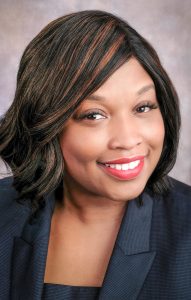Getting included in the conversation – Amber Smith looks to turn small wins into big gains in inclusion and equity


In her former role at the University of Arkansas at Little Rock, Amber Smith’s mission was to change lives for the better. Smith served underrepresented populations and implemented a program that provided students the opportunity to connect with the institution, provide wraparound services and ultimately increase traditionally low graduation rates. “That was the first time I got a specific mission tied to the overarching strategy of the institution,” she said. “I felt like I was impacting change. Not just in students’ lives, but for the institution as a whole.”
A second project, helping underrepresented populations bypass remediation before entering their first year of college through a summer program, was enough to establish Smith in a field she would quickly become passionate about and look for ways to expand her impact. “I began to learn how inclusivity and equity can help positively impact an organization, both from a bottom-line perspective as well as the overall culture of the organization,” she said. “Getting the chance to influence organizational change, that was very intriguing to me.”
Smith, who started at the University of Indianapolis as its Vice President for Inclusion and Equity in January, now turns her focus on advancing those goals in the Circle City. Smith sees the pursuit of equity and inclusion as a campus-wide effort with the goal of her office to help people understand how to connect without fear of vulnerability. Smith wants to work with different colleges and departments independently so that initiatives are specifically tailored.
“Everyone has the goal of being more inclusive and creating equitable opportunities,” she said, “but that looks different for everyone. It isn’t one size fits all.”
She sees her role as a consultant to help examine issues, plan initiatives and eventually bring them to fruition. Especially early in her tenure, her role will be that of information gathering. She plans to do this through a series of interviews and focus groups, SWOC (strengths, weaknesses, opportunities, challenges) analyses, and surveys to students, staff and faculty. “Feedback is of paramount importance,” she said.
Inclusivity and equity are goals that everyone can agree are worthy to pursue—but what do they mean for an academic institution? The mission for the Office of Inclusion and Equity states that “our institution is incomplete without embracing cultural differences and diversity within our student body and workforce.” Putting that in her own words, Smith says “We are all on our own quest. While we’re on it, it feels good to know that we are supported. Not ‘regardless of’ but ‘because of’ our unique differences. Learning and connecting over those differences is how we are all able to belong.”
This is no small task, of course. On a college campus, and in the world at large, there are a near infinite amount of perspectives to consider. Smith says it is important to realize that perception is reality for many people, and that the discussion of inclusivity and equity must start where individuals are mentally in order to make small, incremental changes.
“Sometimes we despise small beginnings, so we don’t recognize the power of small wins,” she said. “When a person evolves from where they are, they can feel that small win. And small wins grow into larger wins.”
Smith says it is important to realize that there are reasons that people have the perspectives that they do. Their personal experiences are informative, and you might not always have the benefit of understanding why they feel the way that they do. “That is evidence in their mind that their approach is right,” she said. “My job is to help them see things in a different light. We must inform – while being careful to not invalidate their experiences.”
Smith also recognizes that one of the biggest roadblocks in achieving equity is that many people look backwards and see large amounts of progress in inclusivity, but still fail to see the continued room for progress in the future. “It’s about moving from the mere presence of diverse populations to the inclusion of diverse individuals, and we all have a role to play,” she said.
“My position is one where I’m able to help people identify a role, help people understand the role they play based on their gifts, talents and experiences and how to execute on that.”
Smith expects students will play a vital role in expanding this discussion on UIndy’s campus. She intends to seek out student opinions and discover their unique experiences. “Coming to the table and voicing how they feel will help me better understand how to do my job effectively,” she said.
Working together with students, faculty and staff, Smith anticipates UIndy forging ahead in the mission of the Office of Inclusion and Equity, fostering a positive environment and turning UIndy into a leading and aspirational educational institution.
“My vision is to create a space where you can be unapologetically you, and where who you are is someone that belongs,” she said. “Unapologetic doesn’t mean combative in this instance, the tone is one of belonging. It’s not a fight. You are who you are, and you are included.”
